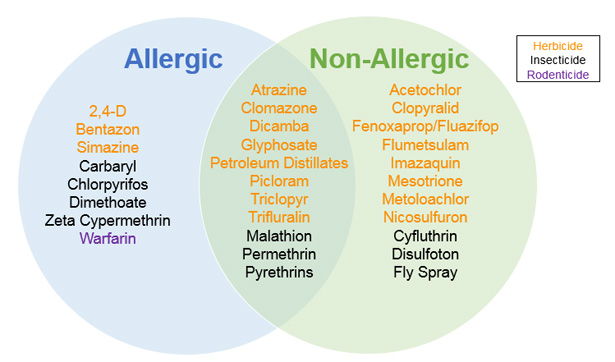Research Associates Some Pesticides With Respiratory Wheeze in Farmers

New research from North Carolina State University connects several pesticides commonly used by farmers with both allergic and non-allergic wheeze, which can be a sensitive marker for early airway problems.
NC State epidemiologist Jane Hoppin and colleagues from the National Institute of Environmental Health Sciences (NIEHS), the National Cancer Institute, Westat and the National Institute for Occupational Safety and Health (NIOSH) used interview data from the 2005 – 2010 Agricultural Health Study (AHS) to evaluate the association between allergic and non-allergic wheeze and 78 pesticides. The AHS is a longitudinal study of farmers and their spouses in Iowa and North Carolina. For the purposes of this analysis, the researchers only used data from the male farmers.
In the current study, 22,134 farmers reported which pesticides they had used in the last year, and specific respiratory symptoms they had experienced. Allergic wheeze was defined as reporting both wheezing and doctor-diagnosed hay fever, while non-allergic wheeze was defined as reporting wheezing but no hay fever. The researchers used this information in statistical models to compare the control group – farmers who had never used the pesticide in question – to those who had used it, and to compare the frequency of either allergic or non-allergic wheeze.
The 78 pesticides included 45 herbicides and plant growth regulators, 25 insecticides, six fungicides, one fumigant and one rodenticide. Of the 78 assessed, 29 were associated with at least one type of wheeze: 19 were significantly associated with allergic wheeze, 21 with non-allergic wheeze and 11 were significantly associated with both.
In the herbicide group, 18 were associated with at least one wheeze outcome, 14 with non-allergic wheeze and 10 with allergic wheeze. Glyphosate, the most commonly used herbicide in the world, was associated with both types of wheeze. Interestingly, the less commonly used herbicide glufosinate ammonium was not associated with either type of wheeze.
In the insecticide group, nine of the 25 were associated with at least one type of wheeze. Permethrin and pyrethrins were associated with both types of wheeze. And in the fungicide, fumigant and rodenticide group, none were associated with non-allergic wheeze, and only the rodenticide warfarin was associated with allergic wheeze.
“This is the most comprehensive list of pesticides in relation to wheeze that has been evaluated to date,” Hoppin says. “Fifty-one of the pesticides we tested in this study had never been analyzed in terms of their effects on respiratory outcomes. And some of them, like glyphosate, 2,4-D and permethrin, aren’t just used on farms. They’re used residentially now to kill weeds or treat fleas on pets. We believe it’s important information that will help people make decisions about pesticides.”
The research appears in Environmental Health Perspectives. Co-authors include David Umbach, Stephani London and Dale Sandler from the NIEHS, Stuart Long of Westat, Paul Henneberger of NIOSH, and Aaron Blair, Michael Alavanja and Laura Beane Freeman of NCI. NIEHS grant Z01-ES025041 and NCI grant Z01-CP010119 provided funding for the work.
-peake-
Note to editors: An abstract of the paper follows
DOI: 10.1289/EHP315
“Pesticides Are Associated with Allergic and Non-Allergic Wheeze among Male Farmers”
Authors: Jane Hoppin, NC State; David Umbach, Stephani London, Dale Sandler, NIEHS; Stuart Long, Westat: Paul Henneberger, NIOSH; Aaron Blair, Michael Alavanja, Laura Beane Freeman, NCI.
Published: Online in Environmental Health Perspectives
Abstract:
Using the 2005-2010 interview data of the Agricultural Health Study, a prospective study of farmers in North Carolina and Iowa, we evaluated the association between allergic and non-allergic wheeze and self-reported use of 78 specific pesticides, reported by > 1% of the 22,134 men interviewed. We used polytomous regression models adjusted for age, BMI, state, smoking, and current asthma, as well as for days applying pesticides and days driving diesel tractors. We defined allergic wheeze as reporting both wheeze and doctor-diagnosed hay fever (n=1,310, 6%) and non-allergic wheeze as reporting wheeze but not hay fever (n=3,939, 18%); men without wheeze were the referent. In models evaluating current use of specific pesticides, 19 pesticides were significantly associated (p<0.05) with allergic wheeze (18 positive, 1 negative) and 21 pesticides with nonallergic wheeze (19 positive, 2 negative); 11 pesticides with both. Seven pesticides (herbicides: 2,4-D and simazine; insecticides: carbaryl, dimethoate, disulfoton, and zeta-cypermethrin; and fungicide pyraclostrobin) had significantly different associations for allergic and non-allergic wheeze. In exposure-response models with up to five exposure categories, we saw evidence of an exposure-response relationship for several pesticides including the commonly used herbicides 2,4-D and glyphosate, the insecticides permethrin and carbaryl and the rodenticide warfarin. These results for farmers implicate several pesticides that are commonly used in agricultural and residential settings with adverse respiratory effects.
This post was originally published in NC State News.


